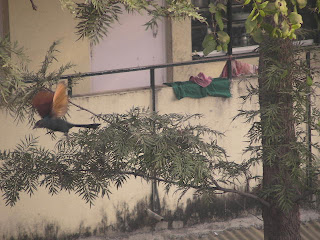The early birds

The Purple Sunbird , Cinnyris asiaticus , is a very small old world passerine bird that feeds mainly on nectar. Less than 10cm long the most prominent feature of this bird is its down-curve bill with brush-tipped tubular tongue.The species is distributed widely from the Persian Gulf through South Asia and into Southeast Asia. They are resident birds in most parts of India distributed over the east of the desert region and south of the Himalayas. The Indian Grey Hornbill ( Ocyceros birostris ) is a common hornbill found on the Indian subcontinent , one of the few hornbill species found within urban areas in many cities where they are able to make use of large avenue trees. About 24 inches long, the call is a squealing call. Mostly spotted in pairs, their flight is heavy and gliding. The Great Tit ( Parus major ) a passerine bird of the Tit family, is a widespread species of temperate Europe & Asia. The great Tit does not usually migrate.14cms in size this bird has a variet...







